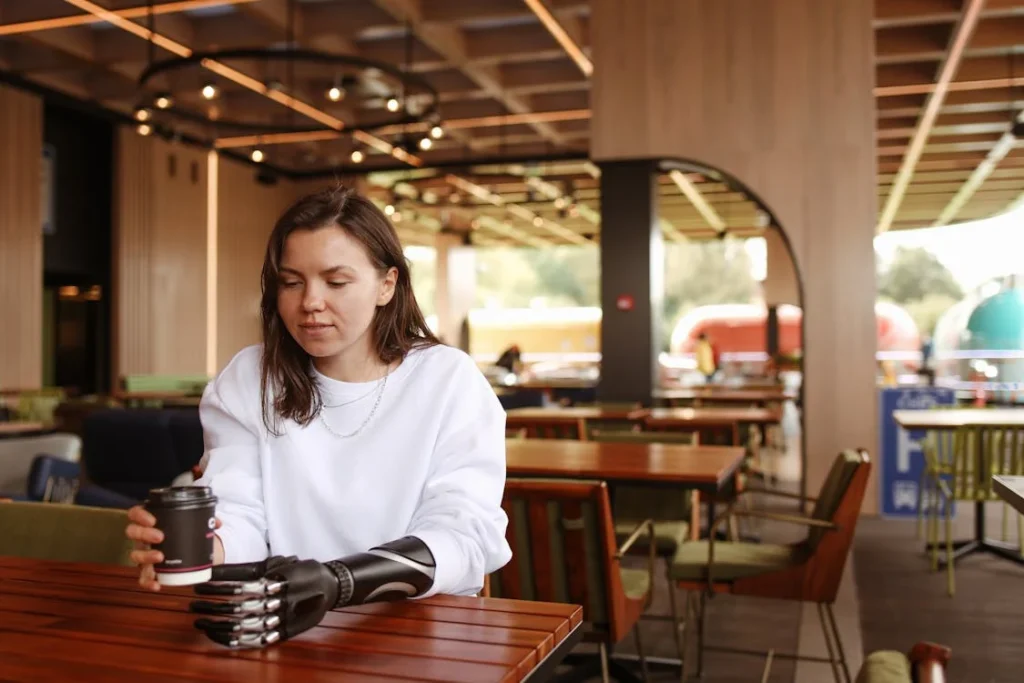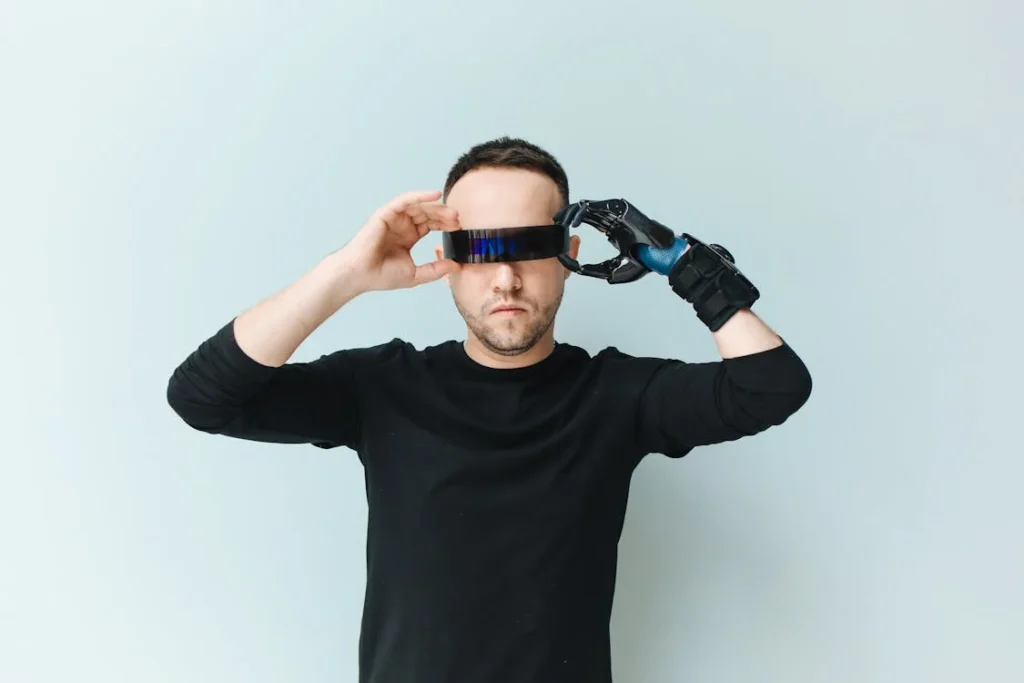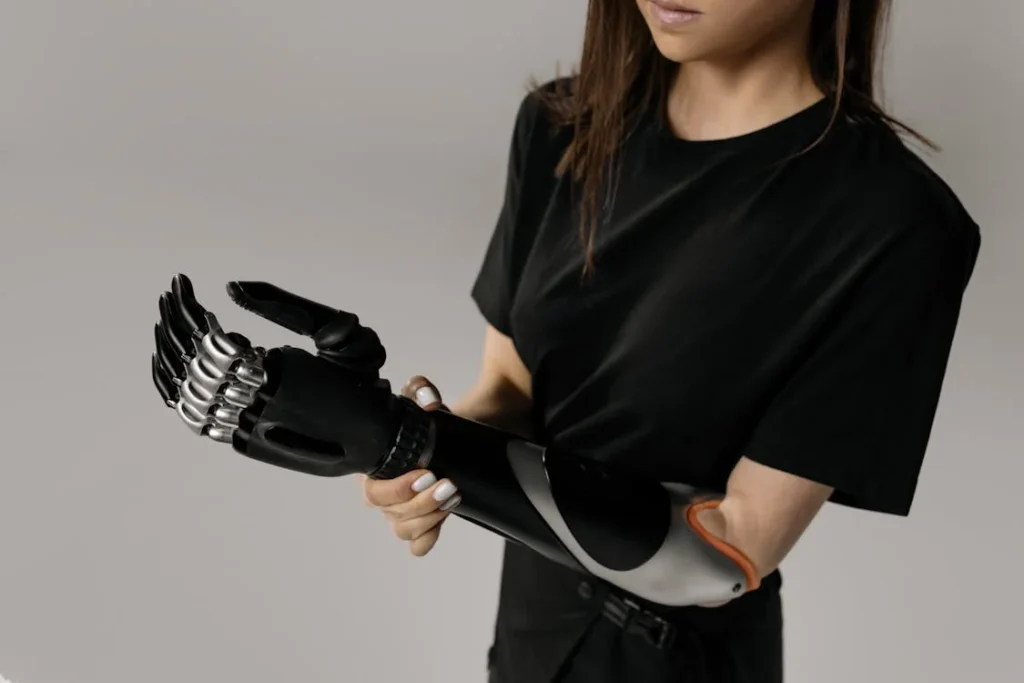Wearing a prosthetic is not just about fitting the device—it’s about learning to live with it every day. For new users, the journey can feel overwhelming at first. Everything from walking, holding things, or even sitting comfortably requires practice, patience, and persistence. Many users start strong, but over time, motivation fades. Some skip days. Others give up entirely.
This isn’t because prosthetics don’t work. It’s because building a new habit—especially one as physical and emotional as prosthetic use—takes more than just willpower. It takes structure, support, and a system that encourages consistency without pressure.
That’s where habit streaks and daily check-ins come in.
At Robobionics, we’ve spent years working closely with prosthetic users. We’ve seen how even the best devices can go unused if daily routines don’t support long-term success. But we’ve also seen users transform their lives—not through big changes, but through small, steady steps they repeat each day.

Why Consistency Is Everything in Prosthetic Adaptation
The Early Days Are the Hardest
When someone first starts using a prosthetic, every movement feels new. Even if the device is perfectly fitted and the design is advanced, it doesn’t immediately feel like part of the body. There’s hesitation in every step. The mind is unsure. Muscles that haven’t been used in a long time get tired easily. Skin may feel sore. There are moments of frustration when something slips or doesn’t move the way you expect.
This phase is where most people struggle the most. And it’s where consistency becomes the deciding factor between progress and plateau.
Wearing and using a prosthetic needs to become a habit, not just a task. It needs to blend into the user’s life like brushing teeth or tying shoes. But habits aren’t formed by big decisions. They are formed by small, daily actions repeated over time. And that’s what makes habit streaks and check-ins such a powerful tool.
How Habits Shape Daily Use
Habits are built in the brain through something called reinforcement. When you do something repeatedly—especially when it leads to a good outcome—your brain starts to make it automatic. The first few times you put on a prosthetic, you might need to sit down, think it through, and go step by step. But if you do it every single day, your brain begins to learn. Soon, you no longer have to think so hard. You just do it.
This doesn’t happen overnight. It takes days, sometimes weeks. But once a pattern forms, it becomes easier to stick with. That’s why missing even one or two days can be risky. It resets the mental progress and makes the user feel like they’re starting over. Habit streaks solve this by creating a visual and emotional reason to keep going—even when motivation is low.
A habit streak is simple. It’s a count of how many days in a row you’ve done a task. For prosthetic users, this could be wearing the device, doing exercises, walking a certain distance, or even journaling how it feels. Every day you check in, your streak grows. And the longer the streak, the harder it becomes to break it. Nobody wants to lose a 10-day streak, let alone a 30-day one.
The power isn’t in the number. It’s in the sense of progress.
Check-Ins Keep You Honest Without Stress
Daily check-ins work side by side with streaks. A check-in can be as simple as tapping a button on an app, writing a note in a diary, or answering one question: “Did I use my prosthetic today?”
Some check-ins go a bit deeper: “How did it feel?” “Did anything hurt?” “Was there a moment I struggled?”
These questions aren’t meant to judge. They’re meant to create awareness.
When users reflect on their experience, even briefly, they become more mindful. They start to notice patterns. Maybe the foot feels stiff in the morning. Maybe a sore spot appears after walking longer distances. These insights help them adjust how and when they use the prosthetic. It helps clinicians too, if the data is shared, as they can make more informed decisions about fit, comfort, or training routines.
But the real benefit is emotional. When someone checks in daily, they feel seen—even if it’s just by themselves. It creates a private moment of self-care. A sense that they are taking control of their own recovery.
This matters. Because prosthetic adaptation isn’t just physical—it’s deeply emotional. And anything that builds confidence, even in small doses, helps.
From Hesitation to Ownership
There’s a shift that happens when a user goes from “putting on” a prosthetic to owning it. It’s not just a device anymore. It becomes part of their identity. That shift usually doesn’t come from therapy sessions alone. It comes from what the user does every day in between.
Habit streaks and daily check-ins help drive this shift. They remind the user, every day, that they are in control. That their effort counts. That their journey is moving forward, even if progress feels slow.
Let’s take a real-world example. One of our users, a young man who lost his hand in a work accident, was given a highly functional bionic limb. But after a week, he stopped wearing it. Not because it didn’t work—but because he felt overwhelmed.
We introduced a basic habit streak tracker. Each day he wore the prosthetic, even for an hour, he marked a check. He also wrote down one sentence about how it felt.
The first week was hard. But he kept going, because the streak made him curious. How many days could he go without missing one?
After 20 days, he told us something surprising. He said he started looking forward to putting it on—not because it got easier, but because it felt like his thing. The habit had made it personal. By day 40, he was using the prosthetic for over 6 hours a day and reported fewer issues. The device didn’t change—but his mindset did.
Building Muscle Memory, Not Just Motivation
One more reason habit streaks are so powerful is that they help develop muscle memory. Just like learning to play an instrument or type on a keyboard, using a prosthetic takes practice. Your body needs to learn how to move with it. Your nerves and muscles must adjust. That learning doesn’t happen in occasional long sessions. It happens in daily short bursts, repeated again and again.
Streaks make sure those bursts happen. Even 10 minutes of focused use can be more valuable than one hour of scattered effort. Over time, those 10 minutes become natural. The muscles remember. The brain stops hesitating. That’s the real magic of habit.
Traditional rehab programs often assume patients will follow instructions every day. But life gets in the way. Motivation dips. Energy drops. That’s why tools that track streaks and promote check-ins can turn “should do” into “want to do.”
It turns passive rehab into active habit.

Tailoring Habit Streaks and Check-ins to Different Prosthetic Users
Every User Has a Different Journey
Not every prosthetic user starts from the same place. Some have lost a limb suddenly. Others have lived with limb difference since birth. Some are children learning to integrate the device into a growing body. Others are elderly, adjusting to new routines later in life. This is why a one-size-fits-all approach to habit-building doesn’t work. For habit streaks and check-ins to actually help, they must reflect the specific needs of the individual.
At Robobionics, we’ve worked with a wide range of users—each with their own story. What we’ve learned is simple: the more personalized the streak or check-in system is, the more powerful it becomes.
Let’s break down how this approach changes based on user type.
Lower Limb Users: Building Confidence in Daily Mobility
For someone using a lower limb prosthetic, walking is a major milestone. But it’s also where fear often shows up. The fear of falling, of imbalance, of pain—it makes some users avoid walking altogether.
In these cases, habit streaks can start small. Instead of focusing on walking long distances, we encourage users to mark a streak every time they put on the prosthetic and take a few safe steps—across a room, down a hallway, even standing still for a moment.
Over time, as comfort builds, the streak evolves. Instead of “wore it for 5 minutes,” the target becomes “walked to the end of the driveway” or “stood while brushing teeth.” These streaks aren’t about hitting perfect goals. They’re about reinforcing action, no matter how small.
Check-ins help too. Many lower limb users experience pressure points, skin irritation, or fatigue. A quick daily note—“heel sore,” or “felt more stable today”—becomes a log that helps fine-tune the fit. It also creates a sense of control. The user is no longer just reacting to discomfort—they’re observing it, managing it, learning from it.
We’ve seen patients go from barely walking with assistance to confidently climbing stairs over a few months, simply because they stuck to their streaks and gave honest daily check-ins.
Upper Limb Users: Precision Through Repetition
Upper limb prosthetics are often used for detailed tasks—gripping, rotating, lifting, pressing buttons. These movements need fine control and regular practice. But unlike walking, they don’t always show dramatic progress right away.
This is where streaks become deeply motivating. A user might begin with “practiced gripping for 3 minutes” or “used my prosthetic hand to hold a spoon.” Over time, those streaks build into routines that are functional—cooking a meal, folding laundry, typing on a keyboard.
Check-ins offer insight into performance. Was the grip too weak? Did fingers respond late? Did the user feel more natural moving the elbow joint? When recorded daily, this data shows patterns. Maybe performance is better in the morning. Maybe fatigue sets in after 15 minutes.
We worked with a college student who used a myoelectric hand. She started by tracking how often she used the device in class. Her streak started at three minutes of use per session. After two weeks, she’d reached 30 minutes. After six weeks, she used it for full note-taking.
That shift didn’t happen from just instruction—it happened through daily repetition and personal data that made her feel in charge of her own adaptation.
Pediatric Users: Turning Streaks Into a Game
Children bring a different kind of energy to prosthetic training—but also different challenges. They’re more likely to get bored, distracted, or emotionally frustrated if something feels “hard” or “unfair.” This is where streaks need to feel like play—not pressure.
For younger users, we often turn streak tracking into a story. Instead of “Day 4 of elbow training,” it becomes “Day 4 of superhero training.” Check-ins aren’t about discomfort—they’re about what the child liked or didn’t like. Did they enjoy using their hand today? Did the leg feel strong like a robot?
This emotional framing turns a clinical task into a personal adventure. And the results speak for themselves. Kids start asking to wear their prosthetics. They come to therapy excited. They want to “keep their streak alive” not because they understand long-term goals, but because they feel proud in the moment.
One boy we worked with refused to wear his arm prosthetic for more than five minutes. After introducing a simple streak calendar with stickers and a fun nickname for his hand, he wore it for 45 minutes a day within a month. Not because we forced him—but because we gave him a reason to feel good about it.
Elderly Users: Respecting Pace While Encouraging Movement
Older adults may face other challenges—arthritis, limited balance, slower healing, and sometimes memory lapses. For them, the habit streak model needs to be gentle, not rigid.
We often suggest simple visual streak charts they can place on a wall or fridge. These don’t need apps or tech. Just a mark for each day the prosthetic was worn. This physical act of tracking helps reinforce memory and provides a small daily sense of accomplishment.
Check-ins here may involve caregivers. A short conversation or phone call asking how the device felt today, whether walking was easier, or if they felt any unusual discomfort. These conversations build trust and reduce the sense of isolation that sometimes comes with aging.
One elderly user we supported shared that marking his daily use on a calendar helped him feel “in control of something” during a time when so much else felt out of his hands. That emotional lift led to more regular walking practice, improved posture, and fewer falls.
Customizing the System Is the Key
What ties all of these examples together is one principle: habit tools must meet the user where they are. The strength of streaks and check-ins isn’t in the format. It’s in the feeling they create—a sense of progress, control, and awareness.
Whether it’s a young child or an experienced adult, a high-tech user or a basic mechanical limb wearer, the goal is the same: help them turn prosthetic use from a daily struggle into a daily ritual.
Not every streak will be perfect. Not every check-in will be cheerful. But when they’re consistent and personalized, they make the difference between a user who gives up and one who thrives.

How Clinics, Therapists, and Families Can Support Habit Formation
Healing Is a Team Effort, Not a Solo Task
When someone receives a prosthetic, the journey ahead is deeply personal—but it should never be taken alone. The user might be the one wearing the device every day, but the success of that journey often depends on the people around them. That includes doctors, prosthetists, rehab specialists, family members, and caregivers.
If habit streaks and daily check-ins are going to work long-term, they need support—not just from apps or reminders, but from real people who understand, encourage, and reinforce those habits gently and consistently.
At Robobionics, we’ve seen time and again that when support systems are involved in daily habit tracking, users go further, faster, and with fewer setbacks.
Clinics Can Integrate Habit Tools Into Appointments
Rehabilitation clinics and prosthetic centers are usually the first places users go after receiving their devices. These settings are where the first habits are built. But often, the focus is so heavy on mechanics—alignment, pressure points, gait analysis—that daily behavior patterns take a back seat.
That’s a missed opportunity.
Clinicians should introduce streak tracking from Day One. Even before the patient goes home, they should explain how daily use, even in small bursts, helps the brain and body accept the device. They can give out simple habit charts, introduce apps with reminders, or provide journals designed for brief, consistent check-ins.
Even better, therapists can review those streaks during appointments. Instead of asking, “Have you been using the prosthetic?”, they can say, “I saw your streak is 14 days strong—how has it felt during that time?”
This changes the tone of therapy. It becomes collaborative. It becomes about teamwork, not checklists. And most importantly, it shows the user that their daily effort matters—not just during sessions, but in between.
Therapists can also use data from daily check-ins to adjust treatment plans. If a user reports soreness every third day, the rehab plan can shift to allow more rest or different training angles. If a streak dips unexpectedly, it may point to burnout or emotional fatigue—signs that should never be ignored.
Families Play a Quiet but Powerful Role
Behind every successful prosthetic user is often a quiet presence—someone in the background helping with the daily routine. This could be a parent, a spouse, a child, or a friend. These people are not just emotional support. They are accountability partners, motivators, and sometimes even co-learners.
When families are shown how streaks and check-ins work, they become part of the system. They can remind the user gently: “Did you log today’s practice?” or “Let’s walk to the corner so you can keep your streak going.” These small moments reinforce the habit without pressure.
It’s important, though, that support never turns into surveillance. Nobody likes feeling monitored. That’s why encouragement works better than correction. A celebration for a seven-day streak goes much further than a scolding for a missed day.
Families can also help with reflection. If a user feels discouraged, talking about it out loud helps. A simple question like “What felt harder today?” can bring insight that a written check-in might miss. It also gives the user a safe space to express frustration or share pride in progress.
Shared Goals Create Shared Success
One of the most effective ways to keep streaks alive is to tie them to shared goals. Instead of saying “wear the prosthetic every day,” say “wear it daily so we can walk together in the park next weekend.” Instead of saying “do your hand exercises,” say “let’s cook together when your grip improves.”
These shared goals connect prosthetic use to life, not just rehab. They make the habit feel less like a chore and more like a path to something meaningful.
Clinics can help users and families set these goals early. Therapists can even write them down during appointments, alongside streak charts, as a visual reminder.
We’ve seen parents of young users create fun streak rewards—movie night after a week of consistent wear, or a trip to the park after daily check-ins. These aren’t bribes. They’re reinforcements that make effort feel worthwhile.
Adults benefit from this too. One user told us he and his wife celebrated his first full month of consistent use with dinner at his favorite restaurant—his first time out in public with the new leg. That meal wasn’t just food. It was validation.
Creating a Culture of Encouragement
In many communities, wearing a prosthetic still carries a quiet stigma. People feel they have to hide it. They feel judged or pitied. That kind of emotional burden can stop someone from even trying to use the device.
This is why a culture of encouragement is so important. When family and clinic staff regularly acknowledge the effort behind each streak—when they say things like “you’ve really stuck with it” or “your consistency is paying off”—they help replace fear with pride.
Some clinics even host support circles or share anonymous user streak stories on bulletin boards. These stories serve as silent mentors for new users. When someone sees that another user has hit 60 days of consistent use, they don’t feel alone. They feel inspired.
This kind of shared motivation can even exist online. Social groups or forums for prosthetic users can offer gentle accountability—daily posts, success shares, even streak contests. The key is not competition, but connection. When people feel like they’re part of something bigger, habits grow stronger.
Support Doesn’t End After Rehab
Too often, the moment a user is discharged from rehab, the support fades. But that’s exactly when they need help the most. At home, without daily appointments, it’s easy to fall off track. Life gets in the way.
That’s why clinics and families should extend the habit system beyond the rehab phase. Whether it’s a follow-up text from a therapist, a weekly call from a clinic coach, or a calendar reminder set up by a family member—these small acts of connection help users stay consistent.
Some of the most successful users we’ve worked with were those who had a check-in partner—someone who asked once a day, “How did it go?” Not to judge, but to care.
Because in the end, the strongest habit isn’t the one built in solitude. It’s the one built through support, reflection, and shared purpose.

How Technology Supercharges Habit Streaks and Daily Tracking
The Right Tools Make Habits Easier to Stick
Habit formation is already powerful on its own, but when combined with the right technology, it becomes even more effective. Prosthetic users today aren’t limited to pen-and-paper logs or vague memory. With mobile apps, sensors, and smart reminders, they can track, measure, and understand their daily progress in ways that were never possible before.
Technology doesn’t just help you remember—it makes you feel more in control. It gives you data. It gives you feedback. Most importantly, it turns what used to be invisible—like small gains in motion or daily consistency—into something you can see and feel.
This visual proof becomes a quiet motivator. It pushes you to keep going, even on hard days. And for many prosthetic users, that’s exactly what makes the difference between giving up and growing stronger.
Mobile Apps: Habit Trackers in Your Pocket
The simplest and most accessible technology for habit-building is the smartphone. With even basic habit tracking apps, users can log their prosthetic use daily, set goals, view streaks, and get reminders.
Some apps let users set specific habits like “Put on my leg prosthetic every morning,” “Grip with my bionic hand for 5 minutes,” or “Take a walk around the block.” Each time the user completes the action, they mark it done. The streak builds. The history grows.
Over time, this builds a sense of pride. A user may start with a two-day streak and think it’s small—but two becomes five, then ten. And when they hit 30 days, it’s not just a number. It’s a story. It’s proof that they showed up every single day, even if just for a few minutes.
Some users prefer visual tracking—apps with color-coded calendars or charts that fill in as habits are completed. Others like simple lists and checkmarks. The key is ease. If the app feels too complicated, people stop using it. The best ones are quick, clear, and responsive.
We’ve worked with users who never thought they’d enjoy digital tools. But once they saw their daily effort in a visual form—once they could say “Look, I’ve worn my arm every day this week”—something shifted. They stopped seeing therapy as a burden and started seeing it as a challenge they were winning.
Sensors and Wearables: Turning Movement into Insight
Beyond apps, more advanced tools are now available for prosthetic users—especially those using myoelectric, robotic, or sensor-driven devices. These prosthetics can track movement, pressure, speed, and other metrics automatically.
When connected to a mobile app or desktop dashboard, these data points give deep insight into how the user is engaging with the device.
Let’s say someone is using a robotic knee joint. The system might track how often the knee bends, how smooth the movement is, or how long the device is worn each day. This data can be turned into feedback: “You walked for 20 minutes today. That’s 5 minutes more than yesterday.”
For users with upper-limb prosthetics, grip force and finger movement can be tracked. If the user is consistently under-activating a certain muscle, the system can alert them. It helps them learn faster. They get real-time coaching without needing to wait for their next rehab session.
This kind of automated check-in is especially helpful for users who struggle with consistency. Even if they forget to log their habit, the prosthetic does it for them. The streak builds in the background. When they review it later, they see not just what they did—but how they did it.
This level of feedback builds a new kind of confidence. It’s no longer “I think I’m doing better.” It becomes, “The data shows I’ve improved every day this week.”
That emotional shift—from guessing to knowing—is what keeps people going.
Smart Reminders That Respect Your Rhythm
One challenge with daily habits is remembering to do them—especially when life gets busy. Smart reminders solve this without becoming annoying.
Many habit apps allow users to set personalized reminders. Instead of a loud, robotic tone saying “Do your exercises,” they can choose a message like, “Time to take one small step,” or “Keep your streak going!”
Some platforms even allow voice reminders from loved ones. Imagine a user getting a gentle nudge from their daughter’s voice each morning: “Dad, don’t forget your hand practice.” That kind of reminder is hard to ignore—and impossible not to smile at.
The key is that these reminders don’t force action. They invite it. They become part of the user’s routine. Over time, the reminders might not even be needed. The habit becomes automatic. But in the early days, they’re the nudge that keeps the wheels turning.
Therapist Dashboards and Remote Monitoring
For clinics and therapists, technology allows for remote check-ins that go far beyond a phone call. Many modern prosthetic systems now come with therapist-facing dashboards that show how often the user is wearing the device, how long they engage with it, and what issues might be happening.
If a therapist sees that a streak suddenly stops, they can reach out. “Hey, I noticed you haven’t worn your device the past few days—anything going on?” That kind of question, based on data, feels more helpful than judgmental.
It also allows therapists to intervene early. If a device isn’t being used because of discomfort or mental blocks, they can address it before it turns into long-term dropout.
Some systems even allow therapists to send encouragements or minor updates directly to the user’s app. A message like “Great work on your 10-day streak!” might seem small—but when it comes from a professional, it feels validating.
Creating a Full Circle of Feedback
What all of this technology does—apps, sensors, reminders, dashboards—is close the loop. Instead of effort going into a black hole, every action creates a ripple. The user sees what they did. The therapist sees what’s working. The family sees progress. Everyone feels involved.
This full-circle feedback system keeps motivation alive. It makes the user feel like every step matters, every day counts, and every bit of effort is visible and valued.
When technology is used not just to track, but to encourage, guide, and celebrate, it transforms rehab from a routine into a journey—with markers, milestones, and real momentum.
And best of all, it gives prosthetic users one simple but powerful feeling: control.

Overcoming Emotional Resistance: Rebuilding Trust in the Self
The Psychological Wall Most Users Hit
For many prosthetic users, especially those who’ve experienced traumatic limb loss, the hardest battles aren’t physical. They’re emotional. Behind every skipped day, there’s often something deeper: fear of failure, shame about visible difference, or the quiet thought that “maybe I’ll never get used to this.”
These thoughts form what we call emotional resistance—an invisible wall that makes the user hesitate, pull back, or delay the work they know they should be doing. They might avoid putting the prosthetic on. They might sit longer on the edge of the bed before attempting to stand. It’s not about laziness or lack of discipline. It’s about doubt.
Habit streaks and daily check-ins—when used with care—can help dissolve that wall. Not by pushing harder, but by rebuilding something more powerful: self-trust.
Why Resistance Often Comes After Initial Excitement
Many users begin their journey full of hope. They’ve just received their prosthetic. They’ve had initial training. People around them are encouraging. But a few days or weeks in, reality sets in.
The device feels awkward. Progress is slower than expected. Friends and family start assuming everything is “normal” again, but inside, the user still feels overwhelmed.
This is when doubt creeps in. Each time the device feels hard to control, or causes discomfort, it confirms the inner fear: “Maybe I’m not doing this right.” And because the body no longer moves the way it used to, there’s a sense of disconnect. You don’t just lose a limb—you lose confidence in your own body.
At this point, some users start pulling away. They skip therapy. They wear the prosthetic less. They stop talking about it. The excitement fades—and is quietly replaced with avoidance.
Small Wins Rebuild Confidence
The most effective way to break this pattern isn’t by demanding bigger effort—it’s by creating smaller wins.
That’s where habit streaks come in. A streak doesn’t say “use the prosthetic perfectly.” It says, “Just show up.” Put it on for five minutes. Flex the fingers once. Take two careful steps. Mark it done.
These are tiny, low-pressure actions. But they offer something the user desperately needs—a feeling of success. When someone who’s been struggling completes three streak days in a row, they feel it. “I did it. I showed up.” It may sound small, but to someone drowning in self-doubt, it’s everything.
As the streak grows, it becomes a symbol. It quietly whispers, “You’re doing better than you think.”
Even when the prosthetic still feels strange or the body moves awkwardly, the streak gives the user a reason to keep trying. Because they don’t want to break it. Because it feels like progress—even when progress is hard to see.
Check-Ins Help Separate Emotion from Identity
When users skip a day—or face setbacks—what often happens next is guilt. And guilt is dangerous. It can quickly turn into identity: “I failed” becomes “I’m a failure.” That thought is poison for recovery.
Daily check-ins, especially when done with compassion, help stop this spiral. When a user writes down how they felt—“too tired today,” “socket felt tight,” “felt discouraged”—they create distance between the feeling and the self.
Instead of internalizing the struggle, they observe it.
That shift is subtle but powerful. It helps users learn that frustration is part of the process, not a sign that something’s wrong. They begin to understand their emotional patterns. They start noticing when they’re most likely to skip and why. That awareness builds resilience.
And resilience, unlike motivation, sticks around.
The Role of Self-Forgiveness in Habit Building
Something we’ve seen time and again: the users who succeed long-term aren’t the ones who never miss a day. They’re the ones who know how to forgive themselves and restart.
Habit streaks often break. Life happens. Pain flares up. Emotions get heavy. But when check-ins are part of the system, users have a place to process the break—not just react to it.
One user once told us, “Writing ‘I missed today because I felt ashamed of how I walked yesterday’ helped me realize I wasn’t weak. I was just hurt.” That one sentence gave him permission to try again. The next day, he restarted his streak—with a new sense of compassion for himself.
This is the hidden strength of check-ins. They turn silence into story. They turn shame into insight.
When the Device Feels Foreign, Habits Make It Familiar
A prosthetic, no matter how advanced, begins its life as a foreign object. It doesn’t feel like “you.” That disconnect can be emotionally painful. Some users avoid the device—not because it’s physically uncomfortable, but because emotionally, it reminds them of what was lost.
But here’s what we’ve learned: the more frequently you use the device, the less foreign it feels. The brain adapts. The muscles adapt. And so does the heart.
Habit streaks create exposure. Check-ins process that exposure. Together, they help transform the device from a daily reminder of trauma into a tool of recovery.
After weeks of use, many users report something unexpected. They say, “I forgot I was wearing it today.” That’s not just a sign of physical adaptation. It’s emotional acceptance. It means the wall of resistance has cracked—and self-trust has returned.

How Prosthetic Designers Can Build Habit Formation Into the Device Experience
Design Is Not Just About Function—It’s About Behavior
At Robobionics, we’ve always believed that a prosthetic is more than a mechanical limb—it’s an extension of someone’s life. And for that extension to truly work, it must fit not just physically, but psychologically. That means thinking beyond joints and sockets. It means designing with behavior in mind—especially habits.
Many prosthetic devices are technically brilliant. They can rotate, grip, stabilize, and respond to sensors. But if they’re not used regularly, none of that brilliance matters. The true success of a device isn’t in what it can do, but in how often it’s used, how naturally it fits into a user’s life, and how quickly it becomes part of their routine.
That’s where habit formation comes in. And the best place to support that habit is right from the start—through the design itself.
Start With Simplicity: Reduce Friction to Daily Use
One of the main reasons users avoid prosthetics is friction—not just physical discomfort, but friction in the experience. If the device is difficult to put on, if the controls are confusing, or if charging it takes effort, users are less likely to build a routine.
Designers can tackle this by asking a simple question during the prototyping phase: “What would make this easier to use daily?”
This might lead to smaller, more modular parts that are easier to clean and assemble. It might lead to quicker strap systems or smarter socket designs that don’t require long adjustments. It might lead to auto-start systems that wake up the device the moment it’s worn, so the user doesn’t have to push a button or wait for pairing.
The fewer steps it takes to start using the device each day, the easier it becomes to make it a habit. And those early days of use are the most important.
Design Interfaces That Nudge, Not Nag
When prosthetics include digital features—like app integrations or smart feedback—they should be designed not to overwhelm the user, but to gently guide them.
At Robobionics, we’ve experimented with subtle visual cues in the companion apps. For instance, showing a small progress circle that fills up with each day of use. Or including a friendly, calm reminder once a day that says, “You’re doing great—want to keep your streak going?”
These small design touches are far more effective than bold red alerts or flashing reminders. People don’t want to feel like they’re being managed. They want to feel like they’re being supported.
Even something as simple as including a customizable streak tracker inside the app gives the user a sense of ownership. Instead of seeing the app as a tool for repairs or settings, they start to see it as a place for personal growth.
The tone of the design matters. Use language that motivates. Keep visuals clean and focused. Make the journey feel light, not clinical.
Physical Feedback for Habit Reinforcement
Not all users are drawn to apps or tech. That’s why physical feedback can play a powerful role in habit reinforcement too.
For example, a simple vibration or light cue when the prosthetic is worn for a certain amount of time can serve as a positive signal. It doesn’t have to say much—just a tap that says, “You’ve hit your 30-minute goal for the day.” These subtle acknowledgements build routine without requiring any manual input.
Designers can even include optional daily timers inside the device—built-in reminders that pulse gently at preferred intervals. This helps those who prefer not to use smartphones or who have limited access to digital tools.
Think of it as sensory encouragement—the device quietly cheering for its user, without words or screens.
Onboarding Should Be Habit-Focused, Not Feature-Focused
Most prosthetic onboarding experiences begin with features: “This button does this. That joint moves like this. Here’s how you charge it.”
That’s important—but it misses the emotional layer.
Instead, onboarding should guide the user into daily routines. Designers can work with clinicians to deliver printed or digital day-by-day guides that align with habit building. Instead of dumping all features in one session, space it out:
- Day 1: Just wear it. Feel the weight. Mark it done.
- Day 2: Grip an object for 2 minutes.
- Day 3: Walk with assistance for a short time.
These guides should build slowly, celebrate effort, and tie each step to emotion. Not just “Use the grip sensor,” but “Hold your coffee cup by yourself today.”
The more designers create experiences that reward presence over perfection, the more likely users are to keep going.
Involve Users in Iteration and Feedback Loops
Habit-friendly design is not something that happens in isolation. The best ideas often come from the users themselves—especially those who struggled, restarted, and eventually succeeded.
That’s why it’s essential to create feedback loops.
At Robobionics, we constantly ask users: “What made you stop using the device?” and “What helped you come back to it?” Their answers drive design updates. If users say, “I didn’t like how the socket rubbed when I moved fast,” we redesign for breathability. If they say, “I wish I had a way to track how long I wore it,” we add usage logs.
Users should feel like co-creators. When they see their ideas shape the product, they become more invested in using it. They no longer feel like patients. They feel like pioneers—adapting something for their life.
That connection drives loyalty, pride, and better long-term results.
Design Is a Silent Coach
Ultimately, the best prosthetic design doesn’t just assist motion. It coaches behavior without speaking. Through comfort, reminders, adaptability, and feedback, it encourages users to show up every day—even when they don’t feel like it.
It’s a partner in healing. A subtle motivator. A daily guide.
And when designers build habit psychology into the DNA of the device, they help users not only wear it—but make it a true part of who they are.
Conclusion
Adapting to a prosthetic is not just about mechanics—it’s about mindset, consistency, and emotional resilience. Habit streaks and daily check-ins turn that journey from something overwhelming into something manageable. One day at a time. One step at a time.
They help users build trust in their bodies, track real progress, and stay engaged even when motivation fades. When supported by therapists, loved ones, thoughtful design, and smart technology, these small actions create lasting change.
At Robobionics, we’ve seen firsthand how streaks and check-ins—combined with empathetic design—don’t just improve prosthetic use. They restore confidence. They rebuild lives.
Because in the end, progress isn’t made in giant leaps. It’s made in the quiet decision to show up every day—and to keep going.



